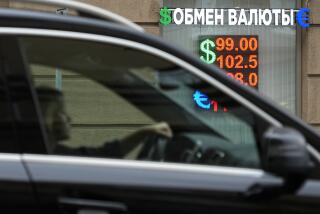Treasury Dept. Moves to Support Sagging Dollar : Currency: But the purchase of greenbacks does little to curb its decline against the yen. Vastness of the market is cited.
- Share via
WASHINGTON — With the dollar’s value seemingly locked into a downward spiral, the Treasury Department put its money where its mouth is, buying dollars Monday in a mostly unsuccessful effort to bring the currency back from yet another postwar low against the Japanese yen.
But the move--taken by the Federal Reserve on Treasury orders in concert with the Bank of Japan--had only a limited effect, demonstrating the difficulty the Clinton Administration faces in its effort to control the value of the dollar.
By the end of the day, the dollar was valued at 86.13 yen in New York, down from 86.55 on Friday, but up slightly from the record low of 86 yen it reached during trading Monday. It also fell against most European currencies, trading at 1.3725 German marks, compared to 1.3735 on Friday.
“The amount involved (in foreign currency trading) is so large that central banks can only influence rates temporarily and to a modest degree,” said Frank McCormick, a Bank of America vice president. Resources at the disposal of the Fed and other central banks pale beside the sums of money--an estimated $1 trillion or more--that private traders exchange each day in the international currency markets, he said.
In a brief written statement, Treasury Secretary Robert E. Rubin said, “We acted in the exchange markets overnight out of concern with recent movements in exchange rates.”
He added, “This Administration believes a strong dollar is in America’s interest, and we remain committed to strengthening the fundamentals that are ultimately important to maintaining a strong and stable currency.”
Beyond the often-arcane world of international currency trading, such statements may appear obvious. But just the slightest hint that the Administration favors a weakened dollar, which can help trim the nation’s trade deficit, can send the markets into paroxysms in which the value of the dollar goes immediately into a nose dive.
While the overall effect of the plunging dollar on the economy may be limited--at least in terms of how it is felt by individual consumers--it can play a long-range role with ramifications felt across the broad spectrum of economic activities.
For one thing, it raises the price of foreign goods sold in the United States because, as the dollar loses value, more of them are needed to buy other currencies or products priced in dollars.
But the falling greenback is also putting pressure on the Fed to increase U.S. interest rates. Higher rates lure foreign investment to the United States, thus increasing the value of the U.S. currency.
Since the beginning of the year, the dollar has fallen nearly 15% against the yen and 11% against the mark.
The Treasury generally keeps intervention activities under wraps, disclosing little more than the fact of the intervention, if that, while keeping details secret. But traders watching the movement of the market suggested that it involved between $1 billion and $2 billion--an amount Bill Dudley, a senior international economist at the Wall Street firm of Goldman, Sachs & Co. called “reasonably sizable but basically not very effective.”
There was a consensus within the international financial community that such steps, without much wider coordination among all the major trading partners and without accompanying interest rate increases, can have no more than a temporary effect.
There is also a feeling, Dudley said, that no significant reversal in the dollar’s fortune is likely for several months and that the currency will await a narrowing of the trade deficit and further strengthening of the U.S. economy, which appears in recent weeks to have been cooling. A stronger economy could lead to higher interest rates as the Fed seeks to keep growth slow enough to avert high inflation.
More to Read
Sign up for Essential California
The most important California stories and recommendations in your inbox every morning.
You may occasionally receive promotional content from the Los Angeles Times.













